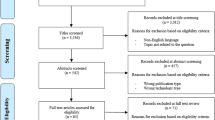Abstract
Internet portals are becoming a very popular entry point to the Web. Users utilise them because of the large amount of information available. This paper aims to highlight the major hurdles disabled and/or older users encounter in Web portals, and to issue recommendations for portals’ layout and structure, based upon the results of a user requirements collection carried out by the authors. The findings point out that provision of a powerful search engine is essential for successful information retrieval. Moreover, due to the diverse and sometimes contradictory needs of the user groups under consideration, the customisation of information presentation plays an important role in ensuring accessibility and usability of Internet portals. The paper also includes a brief overview of the results in relation to the actual working draft of the Web Content Accessibility Guidelines 2.0.


Similar content being viewed by others
Notes
In the rest of the paper we refer to “standard task” as the task performed by all users, common to all of them.
http://web.de/ (see Fig. 2)
References
Brown DJ, Lawton J (2001) Design guidelines and Issues for Web site production for use by people with a learning disability. Foundation for People with Learning Disabilities. http://www.learningdisabilities.org.uk/html/content/webdesign.pdf and http://www.learningdisabilities.org.uk/html/content/webdesign.cfm. Cited January 2001
Caldwell B, Chisholm W, White J and Vanderheiden G (eds) (2003) Web content accessibility guidelines 2.0, W3C Working Draft. World Wide Web Consortium. http://www.w3.org/TR/WCAG20/. Cited 29 April 2003
Chisholm W, Vanderheiden G and Jacobs I (eds) (1999) Web content accessibility guidelines 1.0, W3C Recommendation. World Wide Web Consortium. http://www.w3.org/TR/WCAG10/. Cited 5 May 1999
Coyne KP, Nielsen J (2001) Beyond ALT text: making the Web easy to use for users with disabilities, design guidelines for Websites and intranets based on usability studies with people using assistive technology. Nielsen Norman Group, Fremont, CA
Gappa H, Nordbrok G, Mohamad Y and Velasco CA et al. (2001) Requirements analysis for enabling people with special needs to access Internet-based services. IRIS Consortium, IST-2000–26211
Gulliksen J, Harker S and Steger J (2001) The ISO approach to the development of ergonomics standards for accessibility. In: Nicolle C, Abascal J (eds) Inclusive design guidelines for HCI, Taylor & Francis, London
Jacobs I, Gunderson J and Hansen E (2002) User agent accessibility guidelines 1.0, W3C Recommendation. World Wide Web Consortium. http://www.w3.org/TR/UAAG10/. Cited 17 December 2002
Kobsa A (2001) Generic user modeling systems. User modeling and user-adapted interaction 11. Kluwer, Amsterdam, The Netherlands
Maguire MC, Heim J, Endestad T, Skjetne JH and Vereker N (1998) Requirements specification and evaluation for user groups with special needs. Telematics Application Project TE 2010, Requirements engineering and specification in telematics (RESPECT). http://www.ejeisa.com/nectar/respect/6.2/index.htm. Cited 25 August 1998
Moulton G, Huyler L, Hertz J and Levenson M (2002) Accessible technology in today’s business: case studies for success. Microsoft Corporation, Redmond, WA
Nielsen J (2000) Designing Web usability—the practice of simplicity. New Riders Publishing, Indianapolis, IN
Paciello M (2000) Web accessibility for people with disabilities. CMP Media, Inc., Lawrence, KS
Rubin J (1994) Handbook of usability testing: how to plan, design, and conduct effective tests. Wiley, New York
Stephanidis C, Savidis A (2001) Universal access in the information society: methods, tools and interaction technologies. Universal Access in the Information Society 1(1):40–55
TechDis (2002) Seven precepts of usability and accessibility. http://www.techdis.ac.uk/seven/precepts.html. Cited 2002
Velasco CA, Mohamad Y (2002) Web services and user/device profiling for accessible Internet services provision. In: Proceedings of CSUN’s Seventeenth Annual International Conference, Technology and Persons with Disabilities, Los Angeles, CA, 18–23 March 2002
Velasco CA, Mohamad Y, Gilman AS, Viorres N, Vlachogiannis E, Arnellos A and Darzentas JS (2003) Universal access to information services—the need for user information and its relationship to device profiles. Universal Access in the Information Society (same issue)
Acknowledgements
The authors would like to thank all of the test participants for their collaborations and useful suggestions for this study.
Author information
Authors and Affiliations
Corresponding authors
Rights and permissions
About this article
Cite this article
Gappa, H., Nordbrock, G. Applying Web accessibility to Internet portals. Univ Access Inf Soc 3, 80–87 (2004). https://doi.org/10.1007/s10209-003-0070-x
Published:
Issue Date:
DOI: https://doi.org/10.1007/s10209-003-0070-x




